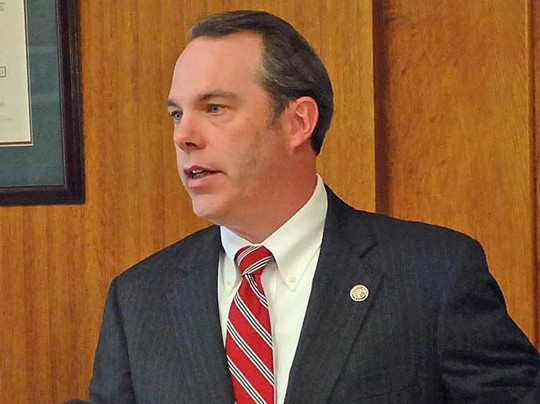Aaron Reardon’s departure as county executive doesn’t end a number of investigations.
By Noah Haglund and Scott North, The Herald
EVERETT — Snohomish County Executive Aaron Reardon left public office about 4 p.m. Friday, ending nearly a decade as the county’s top elected official.
He did not speak with Herald reporters seeking answers about harassing records requests linked to his staff, or how he could explain evidence that he crossed lines intended to keep his political campaigns separate from taxpayers’ money.
A statement attributed to him was posted on the county’s website: “I extend my best wishes to our county officials as they continue their work at the direction of this county’s residents. Finally, and most importantly, I want to sincerely thank the voters of Snohomish County for choosing me on six separate occasions to represent you. It has been a great honor and a sincere privilege to work on your behalf.”
Reardon’s departure cleared the way for other county leaders to focus on hopes that a new executive would bring productive working relationships back to county government.
“I’m very excited about the future,” said County Councilman Brian Sullivan, whose relationship with Reardon, a former ally, soured over the years.
Prosecuting Attorney Mark Roe said he’s hopeful that Monday will bring word that Sheriff John Lovick, of Mill Creek, has been chosen to be the next county executive. Other likely nominees are state Rep. John McCoy, D-Tulalip, and Everett attorney Todd Nichols, a longtime Democratic Party leader at the state and county level.
Reardon’s departure is a significant step in a story with chapters yet unfolding. They include:
•King County Sheriff’s Office criminal investigation — Detectives still are trying to determine whether any laws were broken by Reardon’s staff. The people on the receiving end of public records requests, made anonymously by aides Kevin Hulten and Jon Rudicil, believe they were targets of harassment, surveillance and retaliation for cooperating with a 2012 investigation of Reardon. The State Patrol investigation eventually cleared Reardon of using public funds to carry on a private affair with another county employee.
•Public Disclosure Commission — Two investigations are underway, both focusing on campaign activity in Reardon’s office during his 2011 run for office. One inquiry is examining Reardon’s conduct, including hundreds of calls he made to people who worked on or funded his re-election campaign. The other case is focused on Hulten, and work-day calls he made to state election watchdogs about issues later used to attack Reardon’s opponent, state Rep. Mike Hope, R-Lake Stevens.
•Political changes — The departure triggers reshuffling among county leaders and likely will mean changes for one or more office holders. If Lovick gets the nod, the council will need to name a new sheriff. New leadership also may mean shifts in county priorities.
•More lawsuits — The county could face litigation over some of the controversies that have swirled around Reardon. Some have been threatening lawsuits for years.
Reardon’s parting statement claimed multiple successes in managing the county.
“Together, we have modernized and transformed Snohomish County government from a silo-based bureaucracy to a more dynamic, network-driven organization focused on outcomes as opposed to processes.”
At the same time, Reardon left office by delivering an unwelcome surprise to his County Council counterparts just before he left.
Reardon’s spokesman informed the council that Reardon had signed a memorandum of understanding with the Tulalip tribes regarding land-use planning. That was news to the council. The county’s rules require the executive to first seek the council’s agreement before any intergovernmental agreements are signed. The council planned to take up the issue next week.
Deputy County Executive Gary Haakenson is now the acting county executive until Reardon’s replacement is named.
Because Reardon is a Democrat, it’s up to Snohomish County Democrats to nominate three candidates to take his place. The party plans to convene a special caucus Saturday from 10 a.m. to 1 p.m. in the Everett Labor Temple’s Warren Rush Hall, 2812 Lombard Ave., Everett. The meeting is public.
The party’s central committee will forward the names to the County Council, which then has 60 days to agree on a successor. The council has scheduled public interviews with the nominees for 8:30 a.m. Monday.
The new regime is sure to usher in sweeping personnel changes.
By last week, some of the closest members of Reardon’s staff already had begun making their way toward the exit doors.
Reardon’s finance chief, Roger Neumaier, is in line to be appointed finance director for the city of Edmonds. He awaits the Edmonds City Council’s confirmation on Tuesday. More staff changes are expected.
Voters first sent Reardon to the Legislature in 1997 and he became the youngest county executive in the nation in 2004, at age 33.
His time as the county’s top elected administrator was marked by public feuds with other county leaders and scandals related to his staff and himself. The investigation into his use of county resources while carrying on the affair began in November 2011. And in February he was back under scrutiny after Hulten and Rudicil were linked to the anonymous public records requests, attack websites and other activities targeting people considered the executive’s political rivals.
A week after the story broke, Reardon announced plans for his resignation.
After spending 15 years as an elected public official, Reardon so far hasn’t discussed what he plans next.
To Sullivan, that was typical of Reardon and part of his undoing.
“He’s not a very open person and it’s hard to be a secret person in a public life,” Sullivan said. “I wish him and his family well.”
On Friday, Roe said he is looking forward to a time when the good work being done by Snohomish County government workers has a chance of attracting more attention than serial scandals.
“For the last couple of years I’ve had to listen to Snohomish County jokes from colleagues and friends and family relations, and I’m ready for that to be over,” Roe said.














